
Supermarkets are wonderful places. My old landlord, a friendless and frankly unlikeable person, told me that Gelson’s was her favorite place to spend Thanksgiving (alone). Joe Strummer wrote of getting lost in one, an experience apparently so traumatic that he required Mick Jones to sing his lyrics. The group Supermarket recorded just one song, called “Supermarket,” the lyrics of which consisted entirely of singer Sarah Cracknell hypnotically intoning the word “supermarket.” In “Super Market Love Affair,” Lynda Trang Đài loses her heart “in the aisle between detergents and wine.” In “Common People,” Jarvis Cocker had to “start it somewhere” and so, started it there.
I can relate to all of them.
Before I head down the aisles of this piece, I’d like to note that I’m not sure why so many people refer to markets as “supermarkets.” “Supermarket” is a wholly unnecessary neologism coined in the US in the 1920s but now regrettably and thoroughly spread throughout much of the Anglo and Franco-spheres. Although they succeeded in polluting our vocabularies, now the industry is trying to make “hypermarket” a thing. I urge you to resist. Some are bigger than others but they’re all just markets and I only used the word “supermarket” in the title because I didn’t want to misleadingly suggest that this piece was going to be about something as dull Asian futures and stock exchanges when it’s in fact about something as exciting as Asian grocery stores.
It’s sort of strange to me how few national supermarket chains there are. Growing up in Little Dixie, I was familiar with Temple Stephens, Price Chopper, Kroger, Nowell’s, and Schnucks. One time my mom went to the Islamic Center, where she bought some apricot paste and an unfamiliar variety of pickles. Usually, although she was an adventurous cook, she stuck to the staples. When we’d visit our relatives in Iowa, they all shopped at Hy-Vee. On a scuba diving trip, I remember walking — still in my wetsuit — into a Piggly Wiggly. When I ended up living in Iowa for college, I thought back to what my mom used to buy and tried to do the same. One day, lugging my groceries up the snowy median of a sidewalk-less road it dawned on me that I hate milk, am not particularly fond of sandwich bread, and am indifferent to iceberg lettuce. A rethink was in order.
There was a market much closer to my apartment called East West Oriental Foods, which also included a restaurant, Aoeshe. I found many of the products they carried were actually more to my taste — although I did throw away some nattō because I wrongly assumed from its smell and appearance that it was off. After discovering East West, I discovered “Dirty” Johns and the New Pioneer Food Coop. In the process, I learned something that would’ve been obvious had I not been hypnotized by displays and packaging — that markets all have their own personalities.
The same is true of my local markets in Los Angeles. Trader Joe’s doesn’t have bunches of collards, mustard greens, or plantains. The nearby Ralph’s had all of those as well as horchata and jamaica concentrate but as Silver Lake grew more Anglo, the latter two disappeared from the freezer aisle. Then, symbolizing the completion of Silver Lake’s colonization, the Ralph’s was replaced by a Whole Foods.
I still can’t find decent loose leaf tea, banana ketchup, banana leaves, bananas (other than cavendish), banchan, betel, Buddha’s hand, bitter melon (Chinese or Indian), brown mustard, burdock, calabash, calamondin, calamonsi, carabao, chao, chayote, chili leaves, chili oil, corchorus, cornick, culantro, curry paste, daikon, fish mint, grass jelly, hami melons, Korean Radishes, luffa, makgeolli, mangosteen, mung bean, Okinawan sweet potato, pandan leaves, perilla, pineapple guava, piper lolot, 800 ml bottles of Maggi, Mang Tomas, moringa, nam phrik, napa cabbage, nattō, plum wine, rambutans, rice paddy herb, sea vegetables, shiso, shōchū, Sichuan pepper, snow fungus, soju, sprouted peanuts, any brand of sriracha other than Huy Fong, stinky tofu, taro, Thai basil, Thai eggplant, tofu skin, tsukemono, ube, vegan chicharron, vegetarian “fish” sauce, Vietnamese balm, Vietnamese coriander, water dropwort, water spinach, winged bean, wood ear, yādm (ยาดม), true yams (and not just mislabeled sweet potatoes), yu choy, or tasty jars of peanuts and gluten in soy sauce, which means an adventure by bicycle, bus, or train is in order.
Rather than stocking my apartment like a bomb shelter, I try to take advantage of grocery opportunities. I’ve never been able to plan ahead and don’t really see any point in it because at breakfast time I have no idea what I’m going to want for lunch, much less in five days. So if I’m in the Westside I might grab some English sundries from the Continental Shop. If I’m in Little Arabia, a visit to an Arabic market might be in order. If I can overcome the casein-induced narcotic apathy, I might get something Italian at a Claro’s. Papa Cristo’s has Greek food (and retisina), Supermercado Brasil has Brazilian items, El Rancho has Mexican goods covered, and Merkato has Ethiopian. Of course, Los Angeles being the world’s great Pan-Asian city, there are quite a few Asian Markets and this being Asian Pacific American Heritage Month, here’s my directory of them — just as soon as I briefly address some common complaints from Asian Market Haters (which is a real thing, see In Alhambra, demographic shift reaches the grocery store). Skimming many Yelp reviews the main complaints about Asian markets seem to be the smell, the parking, and of course — the rude staff.
AISLE 1 – SMELLS
Most Anglo markets are sterile and usually, despite being full of food (something which naturally has a fragrance), lack any discernable smells aside from whatever is used to mop the floor every fifteen minutes. On the other hand, there are a lot of ingredients typically found in Asian markets that have strong aromas: ginseng, live fish and fish sauce, durian, and ripe produce — something unsettling for Americans raised on spotless, flavorless, and rock-hard fruits or those for whom now no law is more sacred than the “sell by date.”
AISLE 2 – PARKING
The parking situation is apparently a nightmare at many markets. As a sensible city-dweller, I don’t experience that because I don’t own a car because I’m not homeless and what other reason would there be to own one in a city with a public transit system, sidewalks, and 329 days of sunshine per year? I suppose if you live on top of a mountain, under the ocean’s surface, or inside a gated community, you might be SOL but that’s all on you, isn’t it? And if the parking lot being full of cars is an issue, that’s all on you too.
AISLE 3 – RUDE STAFF
I assume that complaints of rude staff are mostly made by people who’ve never been abroad, where the job descriptions of minimum wage-paid employees don’t include pretending to be BFFs with every customer. If you are looking for friendship, I would warn you that the checkout line at an Asian market is not a place where you’re likely to find one. If it makes you feel better, just know that you’re not that special — they treat everyone that way.
Finally, before I continue, let’s pour one out for fallen Asian Supermarkets… Rest in peace An Dong Market, ASSI Market, Famima!!, Far East Supermarket, Sea Palace, Uni-Mart, and Vien Dong Superfood Warehouse!
A-GROCERY WAREHOUSE (Echo Park) UPDATE — CLOSED!

A-Grocery Warehouse is a Vietnamese market in Echo Park which, in addition to stocking Vietnamese items, also carries a large selection of Chinese, Filipino, Indian, and Thai items. It’s my friendly, neighborhood đồ chua source. In the past I’ve bought both German-made and Chinese-made bottles of the universally loved table sauce, Maggi. The last time I was there I couldn’t find either but picked up a suitable, non-Maggi “maggi,” in this case, Golden Mountain. Although not large, the market nevertheless has a sprawling, labyrinthine feel and unless I’m losing mind, the layout in the main room is constantly shifting. It’s served by Metro‘s 2/302 line stops right next to the building. UPDATE — CLOSED!
AI HOA (Chinatown) UPDATE — CLOSED!
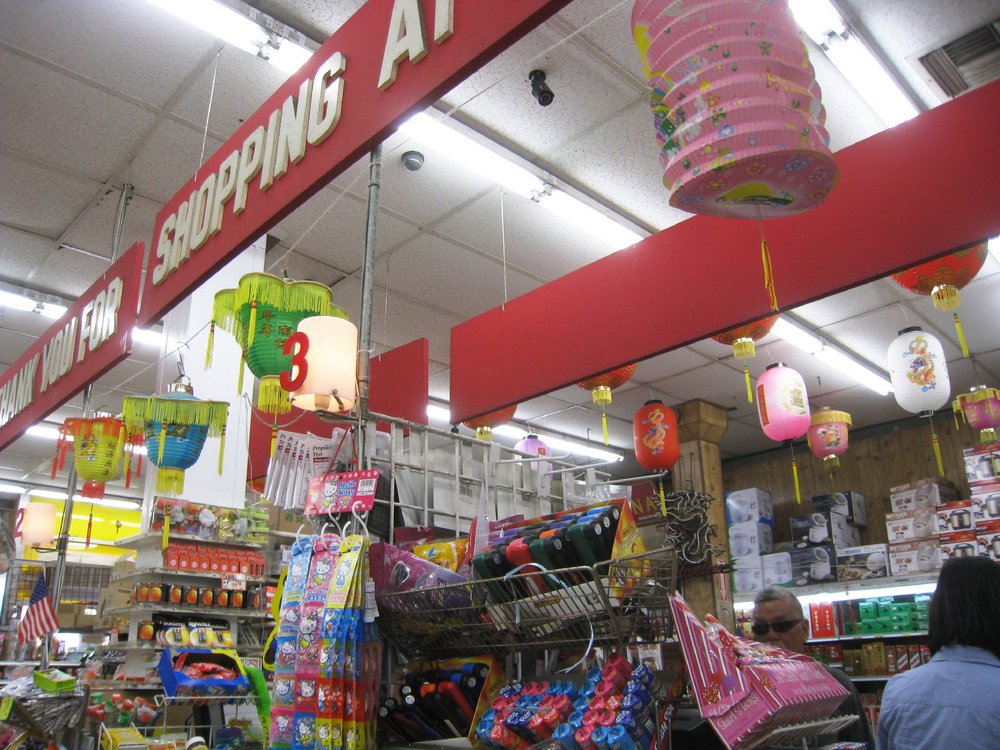
Ai Hoa (愛華超級市場) was formerly a Hoa/Chinese-Vietnamese grocery chain. All of the stores except the Chinatown one have closed. It’s served by Metro’s 81, 90/91, 94, 96, and Rapid 794 lines and Chinatown Station is just two blocks to the east.UPDATE — CLOSED!
ARKO FOOD INTERNATIONAL (Glendale)
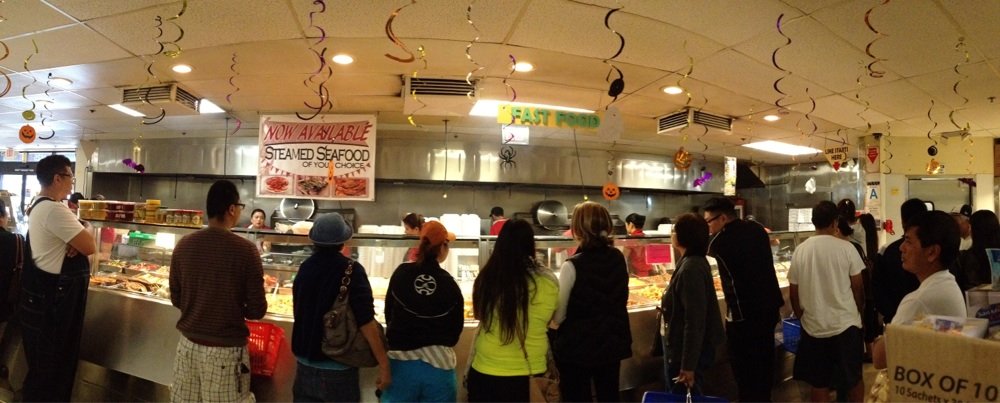
The most popular feature at Glendale’s Arko is likely the large turo-turo food counter which is very popular and so, at mealtime, it can get a bit congested. Being a medium-sized Filipino market, there’s not much that’s vegetarian aside from the produce, condiments, dry goods, and junk food (like Mang Juan vegetarian chicharon). It’s served by Glendale Beeline‘s 6 line and Metro’s 28 line. Arko also caters.
ASIAN MART (Little Bangladesh)
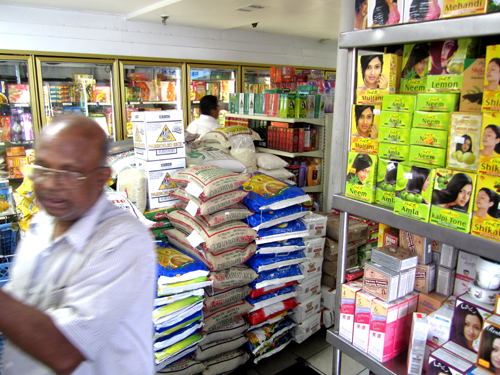
Asian Mart is a small but tightly stocked Bangla market in Little Bangladesh. Given how cramped it is it’s surprisingly clean and orderly. It’s served by Metro’s 16/316 and Los Angeles Department of Transportation (LA DOT)’S DASH Wilshire Center/Koreatown lines.
BANGKOK MARKET (Commerce, Maywood, Melrose Hill – UPDATE — CLOSED!)
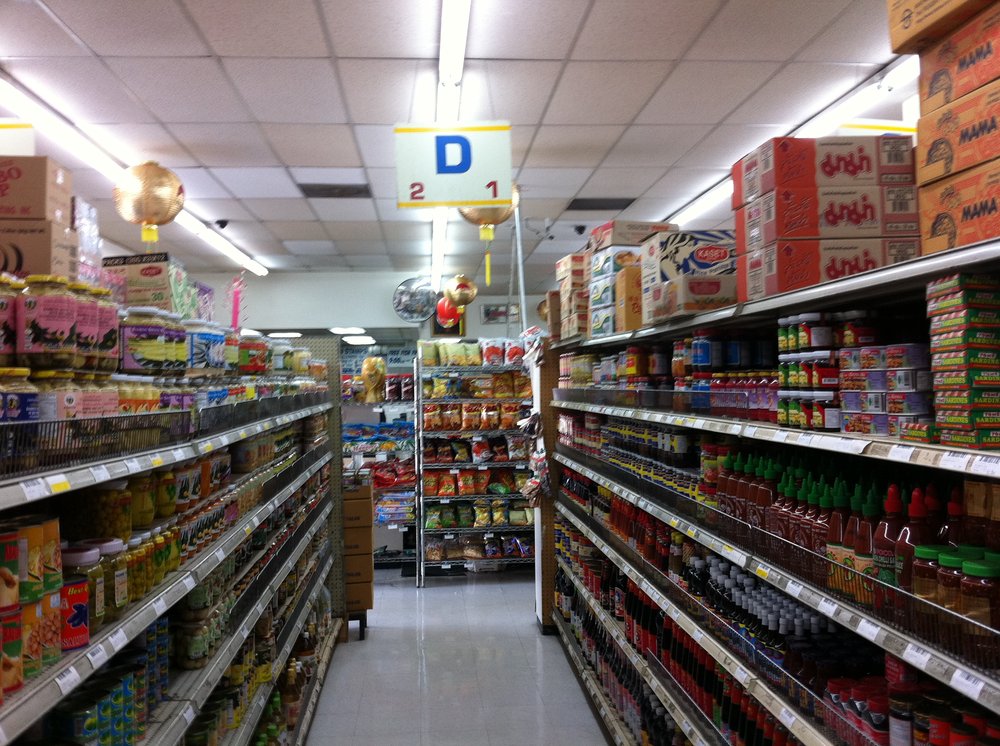
Bangkok Market small-ish Thai market in the East Hollywood neighborhood of Melrose Hill, where there’s a tiny satellite of Thai Town comprised of the market, Khun Dom, and Tid Lom. It was supposedly Los Angeles’s first Thai market and I’m not sure what, if any, politics were involved but Thai Town ultimately took root around another Thai market, Silom (located 2.6 kilometers to the north). In addition to Thai items, there are also Chinese, Filipino, Indonesian, Taiwanese, Vietnamese and other (mostly Southeast) Asian products. It’s served by Metro’s 10/48 line. UPDATE — CLOSED! There are also locations in Commerce and Maywood.
BANGLUCK MARKET (Thai Town, Reseda, and Valley Glen)
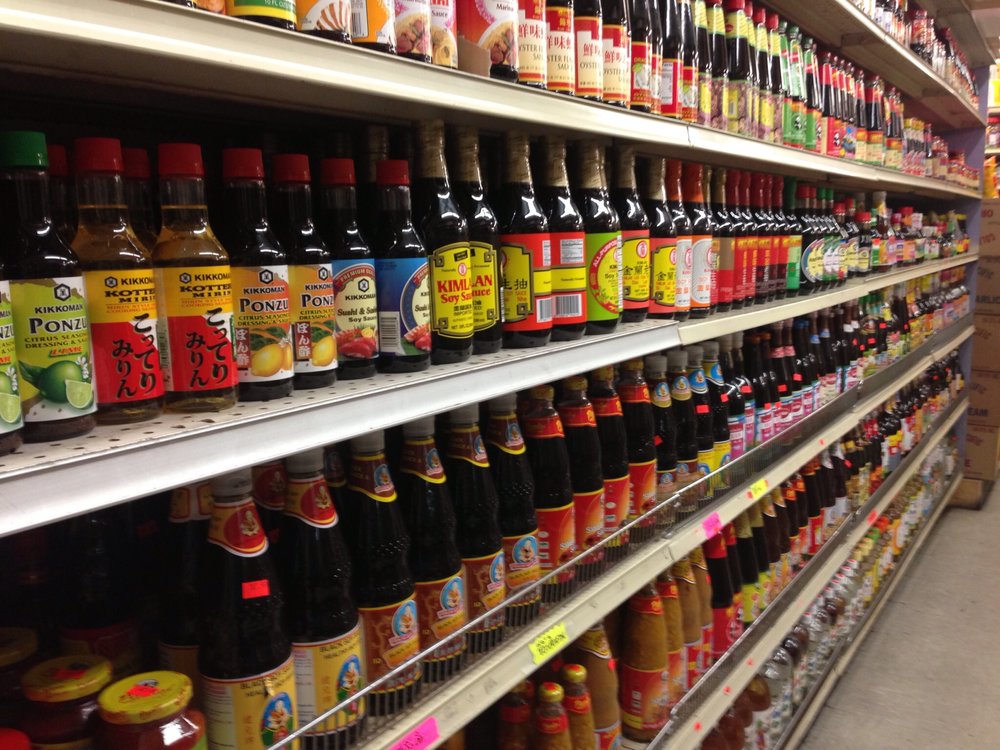
There are no official ethnic enclaves in the San Fernando Valley but of all the regions of Los Angeles, the Valley is surely amongst the most diverse and it seems to me as if nearly every Los Angeles ethnicity not represented by an official enclave can be found there. Bangluck Market in Reseda is small but manages not just to stock a good selection of Thai, Vietnamese, and Chinese goods but even a few selections of Filipino, Indonesian, Japanese, Korean, and Lao items. There’s also sometimes a grill with skewers outside. There’s another Bangluck Market in Valley Glen, next to a Sanamluang. The first Bangluck is also located next to a Sanamluang (and Siam Books Center). Metro’s Red Line subway runs right underneath Bangluck but the nearest station, Hollywood/Western, is four blocks away. Nearer is the stop for Metro’s 180/181, 206, 217, and Rapid 780 lines. The Reseda location is served by Metro’s 150/240, Rapid 744, and LA DOT’s DASH Northridge lines. The Valley Glen location is served by Metro 163/162 and 167 lines.
BAY CITY SEAFOOD SUPERMARKET (Artesia)

Artesia‘s Bay City Seafood Supermarket specializes in Thai products but also carries products from Mexico, the Philippines, and elsewhere. It opened in 2015 and is served by various lines of Cerritos Transit, Long Beach Transit, Metro, and OCTA.
BOMBAY SPICELAND (Northridge)

Bombay Spiceland is not just an Indian grocery store, and not just a grocery store with take-out — they also do henna tattoos. It’s served by Metro’s 150/240 and DASH Northridge lines.
CALIFORNIA MARKET 가주마켓 (Koreatown and East Hollywood (CLOSED))

The first California Market (aka Gaju Market aka 가주마켓) was opened by Richard Rhee in 1987, when he took over the location of a former Mayfair Market. Eventually Rhee opened five more stores and footage of him guarding his stores with a gun during the 1992 uprising was broadcast throughout the world. He later faced numerous labor and tax law violations and died of lung cancer in 1997. The original location was demolished in 2011 and re-opened in a new building in 2015. Almost as popular as the market itself is Koo’s hotteok cart, regularly posted up in front. A second location later opened in East Hollywood and contains a popular jjamppong place. The East Hollywood location closed in 2016. The Koreatown location is served by Metro’s 207 line, and LA DOT’s DASH Wilshire Center/Koreatown and DASH Hollywood/Wilshire lines. Metro’s Purple Line subway stops at Wilshire/Western Station just two blocks south.
DONG MAI SUPERMARKET (Cambodia Town)
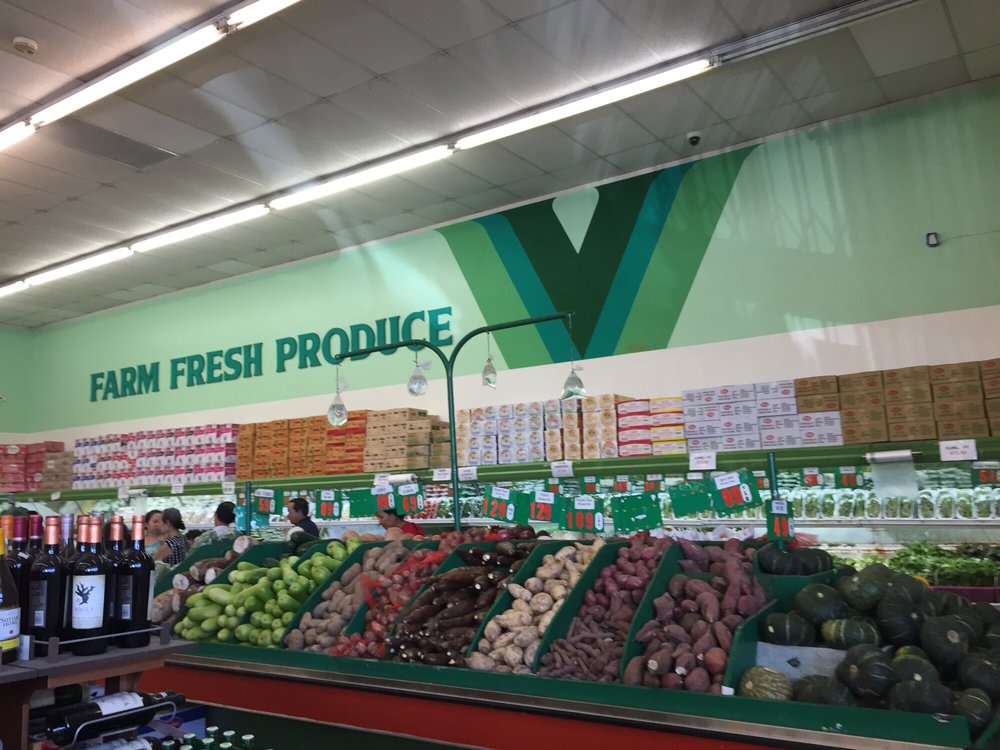
Dong Mai Supermarket opened in Cambodia Town in 2012. It’s served by Long Beach Transit lines 45 and 46.
GALLERIA MARKET (Koreatown, Northridge, Rowland Heights, Wilshire Center)

The Galleria Market, which opened in 2001, is an offshoot of Hankook Market. According to their website, Galleria is to HK as Lexus is to Toyota. The Galleria Market opened with the Koreatown Galleria, where it is the mall’s cornerstone. In 2004, a former Von’s in Northridge became a Galleria Market. In 2009, another Galleria Market opened in Rowland Heights.
HANKOOK SUPERMARKET (Glendale and Wilshire Center)

Hankook Market (HK Market) is established on on Olympic Boulevard in 1975. In 1987, a Ralph’s became a Hankook Supermarket. In 1991 a Hankook Supermarket opened in Rowland Heights but was sold in 2004. A location followed in Gardena in 1996 but was sold a year later. There remain locations in Glendale and Wilshire Center. The Wilshire Center location is served by Metro’s 207 and LA DOT’s DASH Hollywood/Wilshire Center lines. The Glendale location is served by the Glendale Beeline’s 5 line.
HANNAM (Buena Park, Diamond Bar, Fullerton, Koreatown, La Palma, Torrance, Walnut)
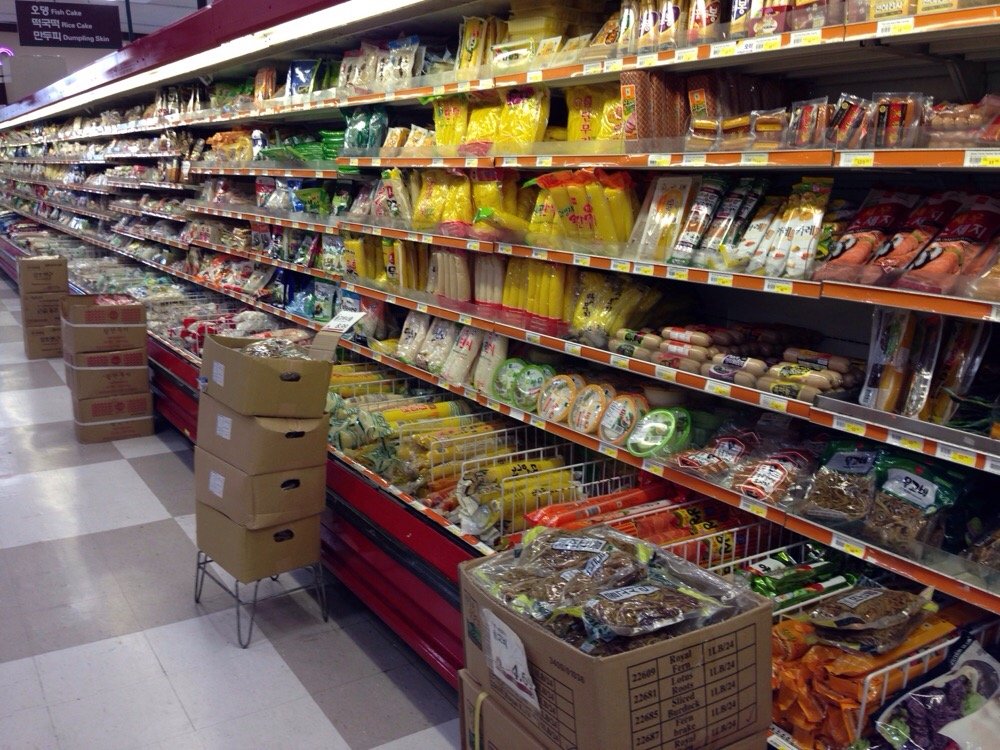
Hannam is a chain with locations local locations in Diamond Bar, Fullerton, Koreatown, La Palma, and Torrance. There’s also one in New Jersey. The original location is the Koreatown one, founded in 1988. Sometimes the stores are branded differently, for example Super 1 Mart, Family 153 Mart, or S-Mart. As with a lot of Korean markets, they share their roofs with many smaller tenants including banks, beauticians, florists, nutritionists, restaurants (which Supermarket News refers to as “grocerants”), and travel agencies along with dealers of cosmetics, jewelry, phones, &c.
HAWAII SUPERMARKET 夏威夷超級市場 (San Gabriel)
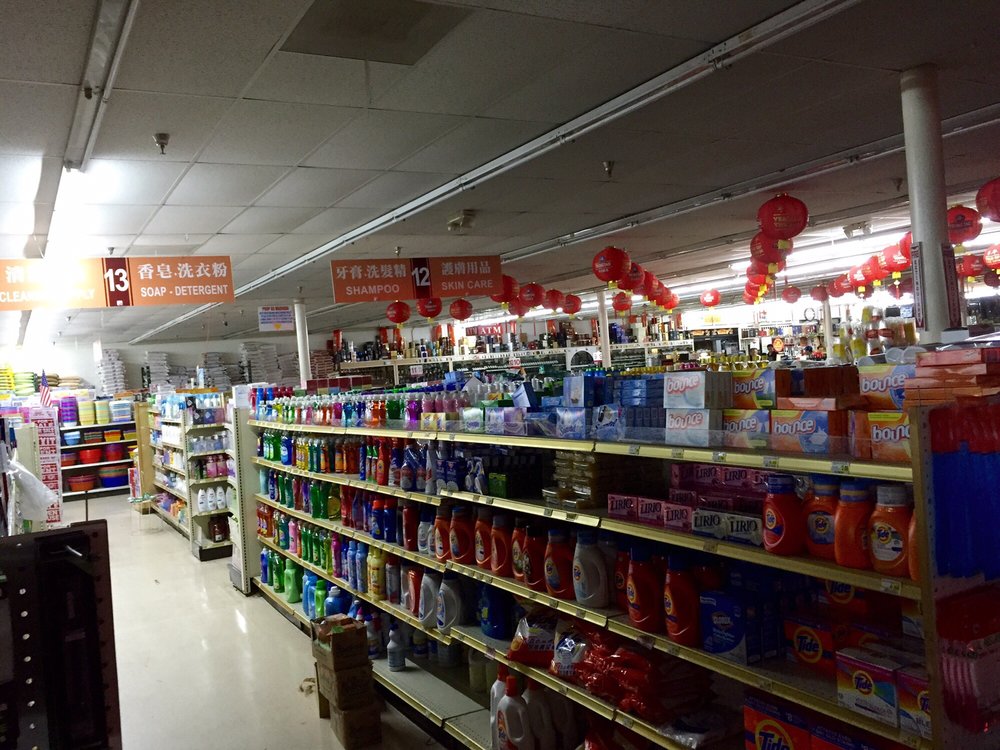
Hawaii Supermarket, in San Gabriel, carries very little in the way of identifiably Hawaiian products… a fact which seems to confuse a great many gweilos like myself. I guess people expect coconut tops, grass skirts, and surf boards. I’ve never been to Hawaii but, like San Gabriel, it’s an Asian-majority place where Filipinos and Japanese outnumber all European nationalities. Therefore the only “Hawaiian” product I’d expect to find here is Spam, which isn’t actually Hawaiian but I am assured is on the shelf. Metro’s 76 and 487/489 lines stop right at Del Mar and Valley.
H-MART (Buena Park, Diamond Bar,Garden Grove, Irvine, Koreatown)
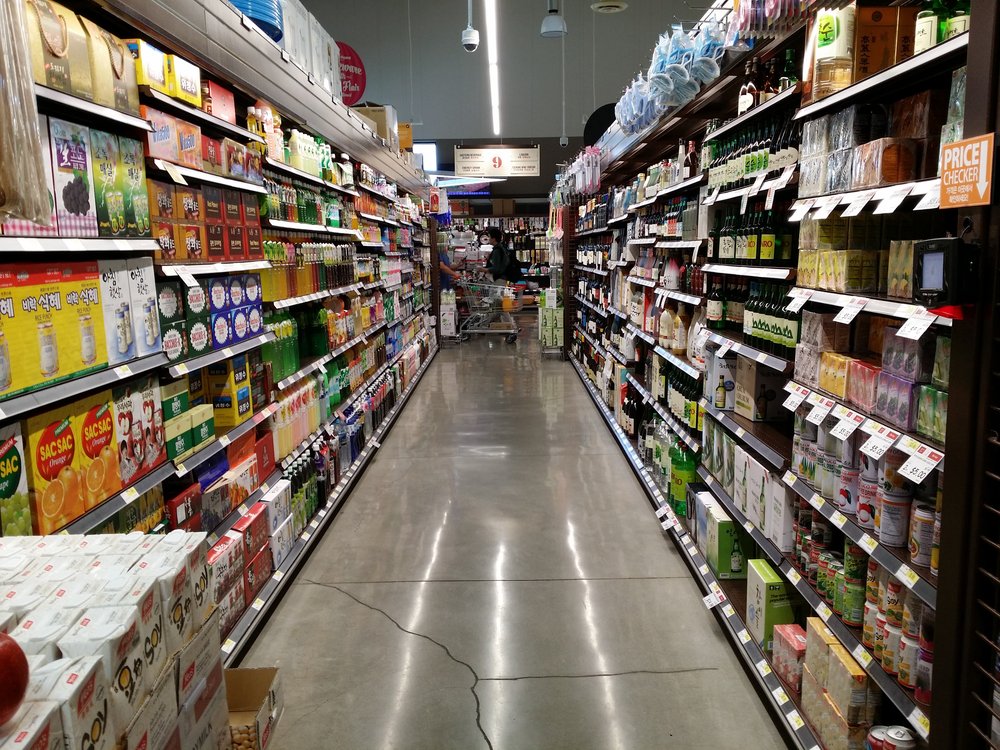
There are locations of H-Mart (a Korean market chain established in the 1982 in Queens) across the country. The “H” stands for “han ah reum,” or “armful of groceries.” The first local H-Mart opened in Diamond Bar in 2007. It was followed by locations in Irvine, Garden Grove, Buena Park, and Koreatown.
HEARTLAND ORGANIC & NATURAL FOODS GROCERY STORE|心田天然有機商店 (Artesia, Diamond Bar, Irvine, San Gabriel, and Walnut)
Taiwanese Heartland Organic & Natural Foods opened its first café in Walnut in 2002. They’ve expanded operations to vegetarian markets, Heartland Organic & Natural Foods Grocery Store|心田天然有機商店 in Artesia, Diamond Bar, Irvine, and San Gabriel. Their stores are stocked with organic, vegetarian products from Taiwanese health store chain, LeeZen 里仁 as well as selections of European and North American brands.
HONG KONG SUPERMARKET 香港超级市场 (Hacienda Heights, Monterey Park, Rowland Heights, San Gabriel, West Covina)
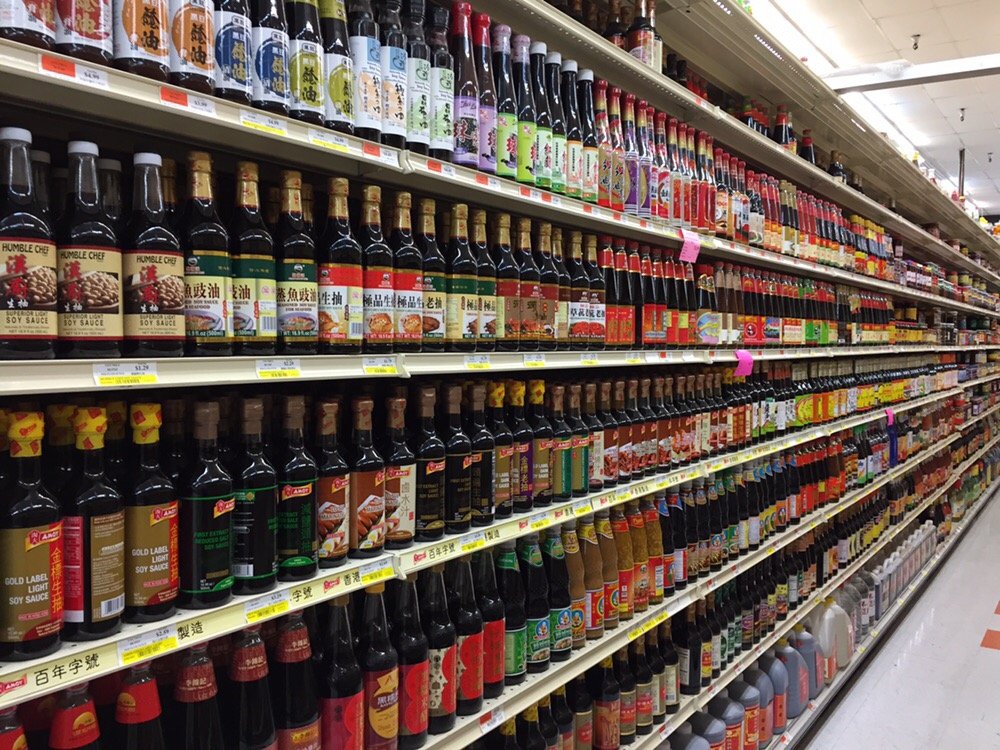
The Chinese supermarket chain, Hong Kong Supermarket, was founded in Monterey Park in 1981. The chain specializes in imported groceries from China, Japan, Korea, Thailand, Taiwan, Vietnam, Indonesia, and the Philippines, tailoring the selection to the local Asian community. For example, the store in Monterey Park caters more to Chinese whilst the Rowland Heights location caters to Taiwanese. I haven’t been to the West Covina branch but I’d not be surprised if there are more Filipino and Indonesian products at that one than the others. There are also locations in Hacienda Heights, San Gabriel and four states in the Northeast.
INDIA SWEETS & SPICES (Artesia, Atwater Village, Canoga Park, Carthay Square, Culver City, Duarte, Northridge, Riverside, Tustin)
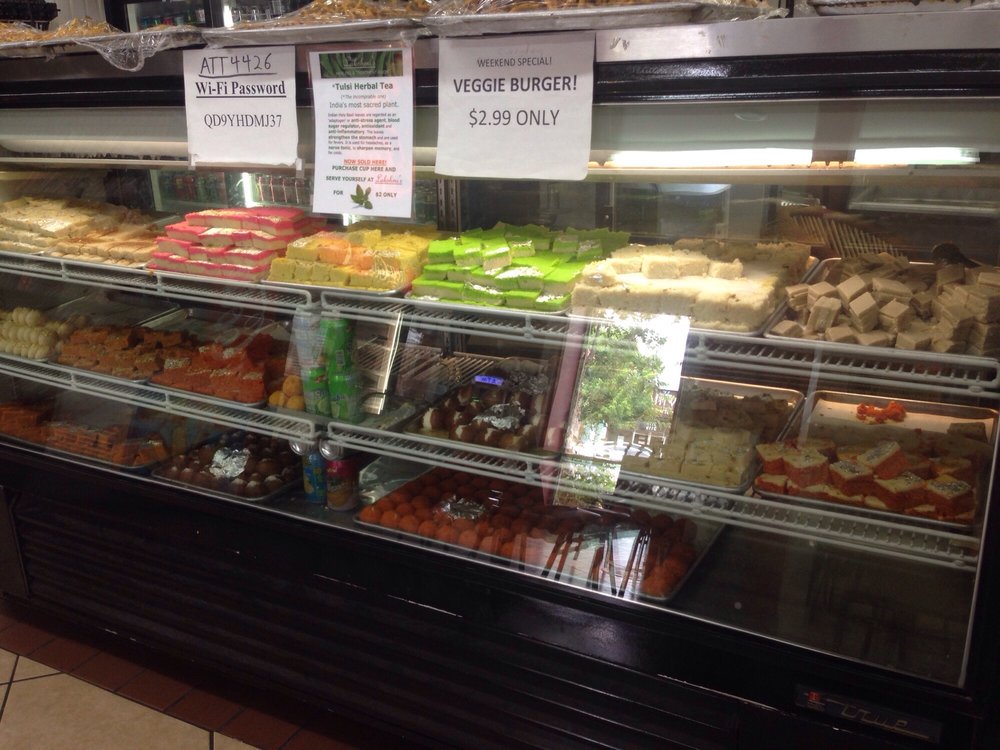
India Sweets & Spices was founded by Kumar Jawa in 1984 in Culver City. The store carries a selection of Indian spices, breads, sauces, pickles, and pastes as well as some Bangla, British, Chinese, Pakistani, and Sri Lankan products. The attached restaurants serve some of the best Indian food to be found in Southern California.
INDO LANKA CASH & CARRY (Little India and Lake Balboa)
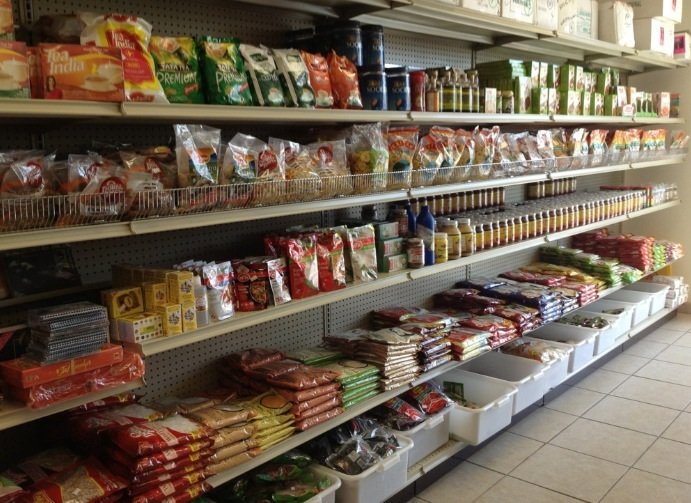
Indo Lanka Cash & Carry is a small market specializing in Sri Lankan and Indian (mostly Keralite) items. The Lake Balboa location is served by Metro’s 165 and 236/237 lines and LA DOT’s Commuter Express lines 573 and 574 lines. The Little India location is served by several lines of Cerritos On Wheels (COW), Long Beach Transit, Metro, and Orange County Transportation Authority (OCTA).
ING’S MARKET (Long Beach)

Ing’s Market opened in 2007 in Long Beach and is threatening to bust at the seams. It’s served by Long Beach Transit lines 171, 172, 173, and 174.
ISLAND PACIFIC SUPERMARKET (Canoga Park, Cerritos, Dayton Heights, Industry, Little Bangladesh, Rancho Cucamonga)

Island Pacific is a Filipino market founded in 2000, with headquarters in Industry. There are several local locations locally, including Canoga Park, Cerritos, Dayton Heights, Industry, Little Bangladesh, Rancho Cucamonga and more distant ones in Pittsburg, Union City, and Vallejo.
KAVITA GROCERY (Palms)

Kavita Grocery is a small Indian grocery store located in Palms, near a part of Culver City in which there are several Indian businesses. It’s served by Metro’s 33 line.
KIM LONG MARKET (Cambodia Town)

Kim Long Market, like many Cambodia Town markets, has a substantial ready-to-eat section of prepared foods. They’ve also got, like their Khmer competitors, a selection of Thai and Vietnamese products. It’s located a block east of the Metro Blue Line‘s Anaheim Street station and is also served by Long Beach Transit lines 1, 51, 52, and 60.
K-H SUPERMARKET (Cambodia Town)

Cambodia Town’s K-H Supermarket (short for “Kun Heng”) carries a produce and Cambodian goods and is specially popular for its snacks and desserts. It’s served by Long Beach Transit lines 45, 46, 71, and 72.
LAX-C (Dogtown)

Founded in 1996, LAX-C is a huge market in Dogtown occasionally described as the “Thai Costco.” It’s so big that I’ve been in corners of it where I felt like no one else had been in decades and there was a family of cats lurking in the dusty, dark, corners. It’s located in an area of Dogtown which I think of as Little Xishuangbanna Dai, because there’s a pocket of Thai businesses in a Chinese-dominated area: Chimney Coffee Shop, E-Sea Fresh Seafood (aka E-Sea Fresh Noodle), Mae Ting’s Coconut Cakes, Rajprasong, Thong Lo, Thai Books & Music-Dokya, and Thai LA Newspaper. LAX-C is served by Metro’s 76 line and LADOT’s DASH Lincoln Heights/Chinatown line. A block west is the Metro Chinatown station, served by the Gold Line.
LITTLE TOKYO MARKETPLACE (Little Tokyo)
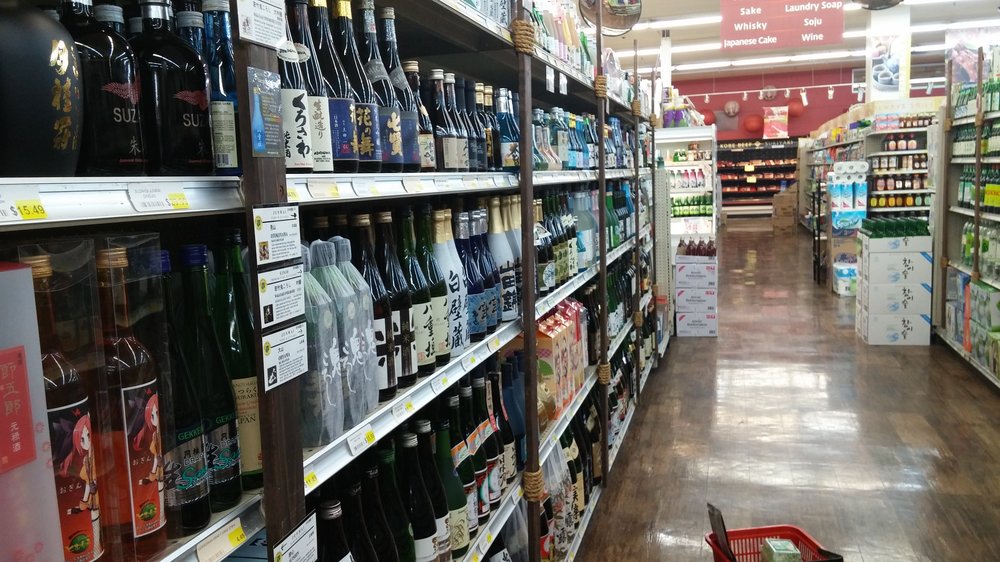
Little Tokyo Marketplace is the current name of the Korean market formerly known as Woori Market, located in the Little Tokyo Galleria in Little Tokyo. The market opened as the Yaohan Market along with the bleak, bunker-like Yaohan Plaza in 1985. A Cuban-American real estate developer bought the struggling mall in 2000 and renamed it the Little Tokyo Galleria and the Yaohan Market then became a Mitsuwa. The mall continued to struggle, usually remaining between 35 and 40% vacant, until a group of Korean developers bought it in 2009. The market’s tea and tsukemono sections shrank and Japan Arcade closed but the mall’s a lot more lively now. At some point Woori took a less obviously-Korean name, Little Tokyo Marketplace — although there are still some signs referring to “woori” (우리). Subtenants include a ramen place, Bliss Bakery, an herbal medicine shop, and a sunglasses counter. It’s served by Metro’s 18, 53, and 62 lines as well as LA DOT’s DASH Downtown A line.
LOHAS Fresh Mart (Alhambra, Arcadia, Diamond Bar, and Rowland Heights)
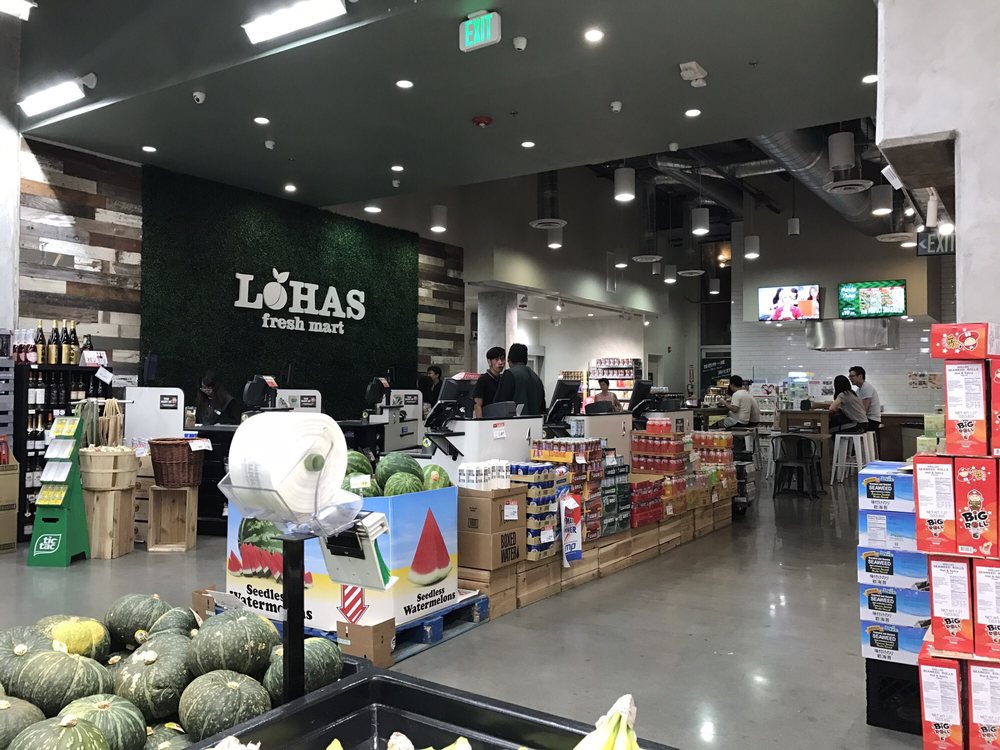
LOHAS Fresh Mart is a market chain with four locations in the San Gabriel Valley founded by Taiwanese-American grocer, Joseph Lee. The first one opened in Alhambra in 2014. “LOHAS” stands for “Lifestyles of Health and Sustainability” and there’s a typically Taiwanese focus on cleanliness, order, and tidy appearance.
LOTTE (La Cañada Flintridge)
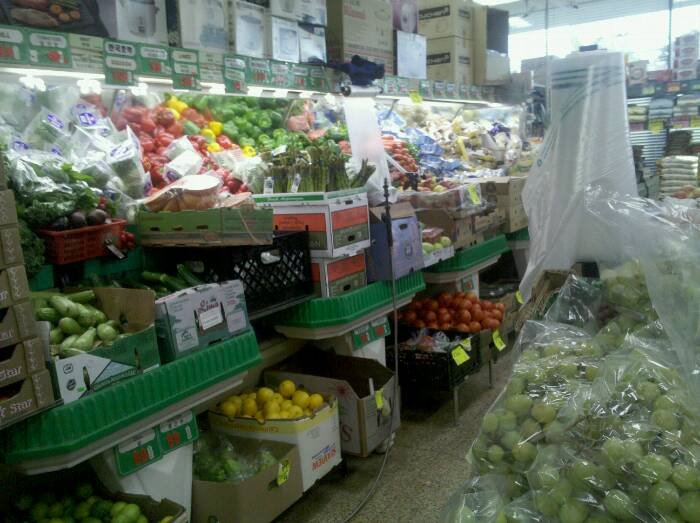
Lotte is a Korean market chain founded in Korea by Shin Kyuk-Ho. The first overseas location opened in 2006, and as of 2011 the chain had 199 branches including in China, Indonesia, Vietnam, and the US. The La Cañada location is served by Glendale Beeline lines 3, 32, 33, and 34 lines.
LUTONG BAHAY (Glassell Park)
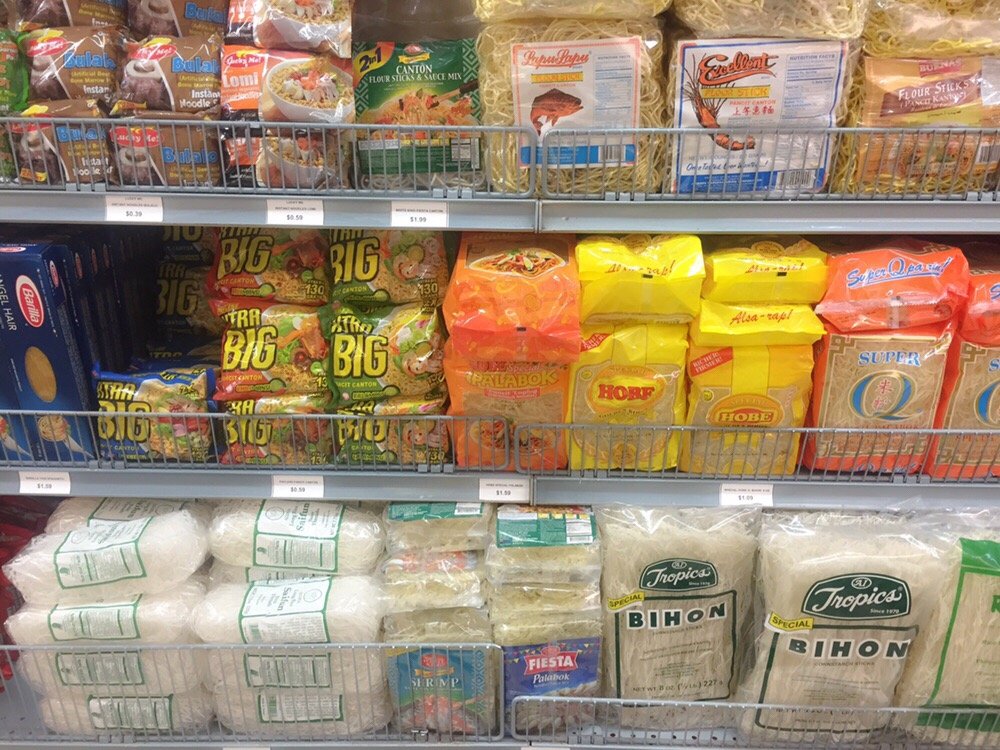
Lutong Bahay has a small selection of Filipino groceries but judging by the lines, most come for the turo-turo. The Glassell Park location is served by Metro’s 28 and 685 lines. There’s also a location in Norwalk but it seems to be a turo-turo joint and not a market at all.
MARUKAI (Costa Mesa, Gardena, Little Tokyo, Sawtelle, Torrance, West Covina)

The first Marukai Market, was co-founded by Hidejiro Matsu and his brothers and opened in Gardena in 1981. There are currently eleven locations in California and Hawaii. The first Marukai Forum opened in Gardena in 1996 is a huge store selling not just groceries but electronics, clothing, stationery, home furnishings, &c. Locally there are locations in Costa Mesa, Gardena, Little Tokyo, Sawtelle, Torrance, and West Covina. In 2013 the chain was sold to Tokyo-based Don Quijote and Matsu left to start Seiwa Market.
MGA LUTONG BAHAY (Eagle Rock, Hel-Mel, Little India)
Mga Lutong Bahay is, according to Google Translate, Filipino for “home cookies.” The business’s name is nevertheless translated to American Ranch & Seafood Market in English. It was established in 2006. Most, perhaps all three locations, also include a full restaurant area.
MITSUWAミツワマーケットプレイス (Costa Mesa, Irvine, Mar Vista, San Gabriel, Santa Monica, Torrance)

Mitsuwa is a Japanese chain founded in 1972 in Torrance. Today there are locations not just California but Illinois and New Jersey. Locally there are locations in Costa Mesa, Irvine, Mar Vista, San Gabriel, Santa Monica, and Torrance. The former Little Tokyo location was purchased in 2009 and turned into Woori Market, later renamed Little Tokyo Marketplace. The Torrance location is the anchor of Eastgate Plaza, a bustling Japanese shopping center which rivals many cities’ Japantowns.
NIJIYA MARKET ニジヤ マーケット (City of Industry, Little Osaka, Little Tokyo, Torrance)
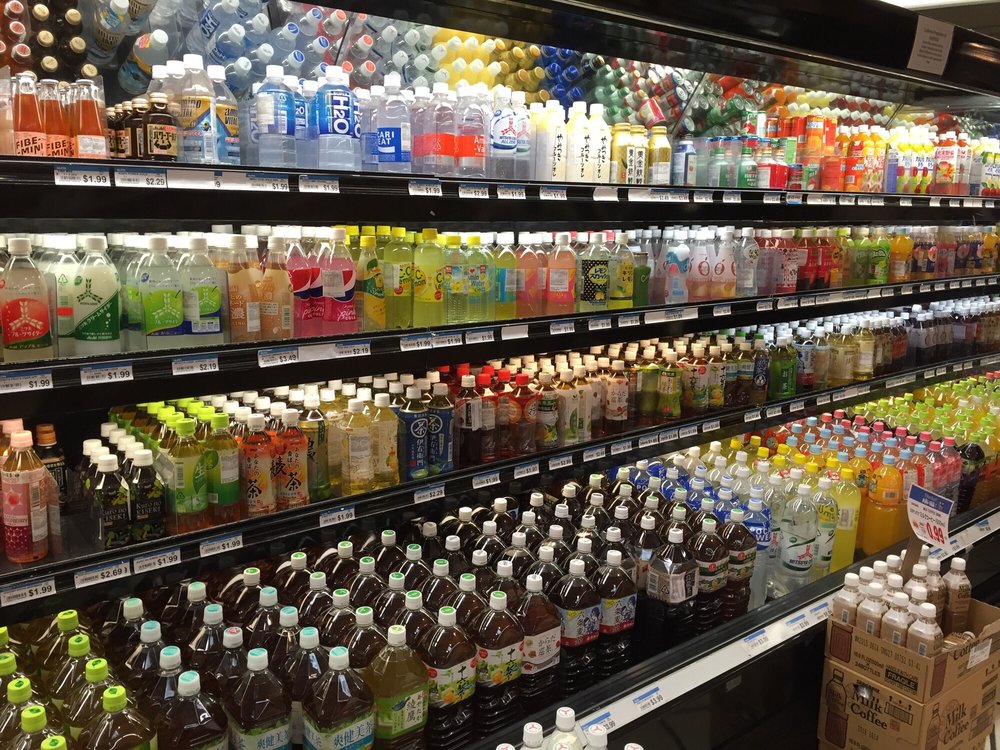
Nijiya Market is a Japanese chain with local locations in Industry, Little Osaka, Little Tokyo, and Torrance. The original location is the Torrance one, which opened in 1986. Today there are also locations in Hawaii and New York.
99 RANCH MARKET (Alhambra, Anaheim, Arcadia, Chino Hills, Gardena, Hacienda Heights, Irvine, Monterey Park, Rowland Heights, San Gabriel, Van Nuys)

99 Ranch Market is the largest Asian-American supermarket chain on the west coast. The Chinese chain was born in Little Saigon in 1984 although that location later became a Shun Fat Supermarket. Its founder, Ho “Roger” Yuan Chen, was an immigrant from Taiwan, who established the store’s parent company, Tawa Supermarket Inc., in 1985. There are, locally, locations in Alhambra, Monterey Park, and Van Nuys.
168 超級市場168 MARKET (Alhambra, Hacienda Heights, Rowland Heights, San Gabriel)
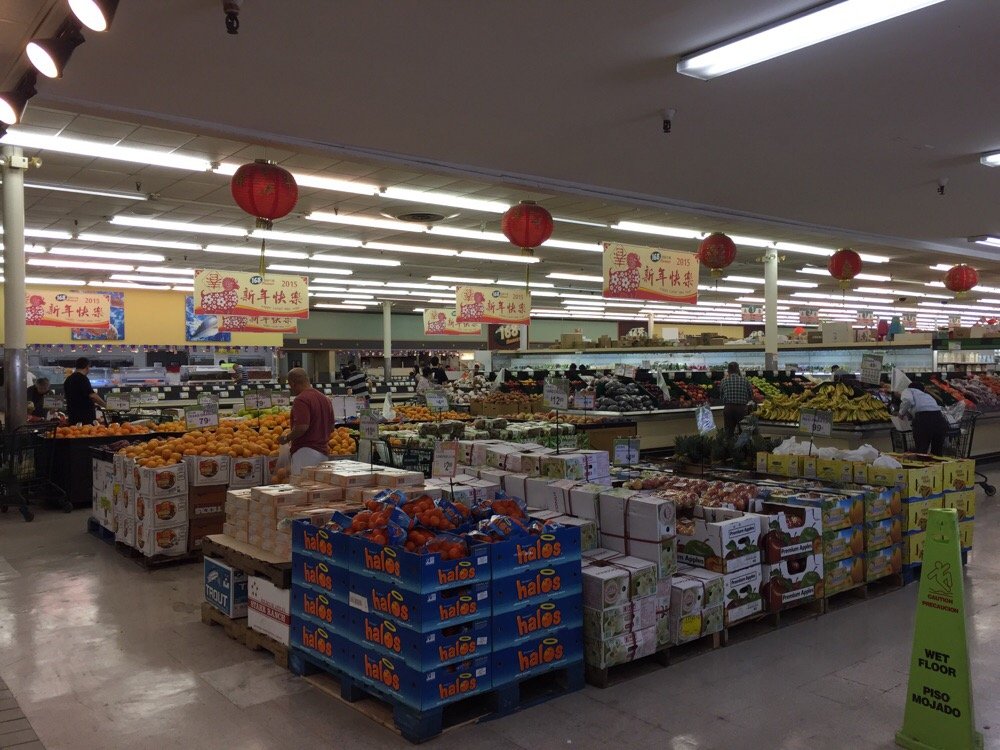
168 Market was founded in 2006. Like 99 Ranch, it is owned by Buena Park-based Tawa Supermarket, Inc. There are currently four locations in California and one in Nevada. The Alhambra location, which I believe was the first, occupies a former location of Crawford’s Corner, a supermarket chain with New Orleans-themed design which used to feature live Dixieland Jazz bands playing in the gazebo, which remains.
PLAZA MARKET (Koreatown)
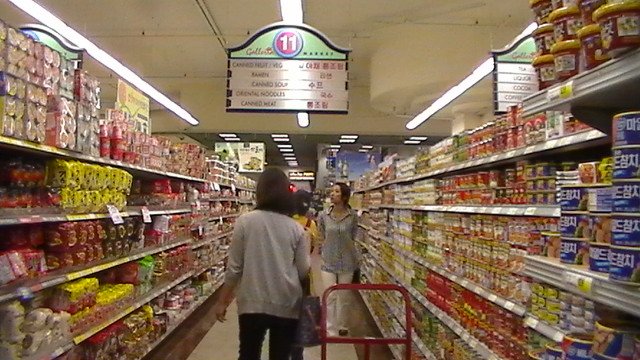
Plaza Market is a large grocery store located on the bottom of Koreatown Plaza. The plaza opened in 1988. It’s served by Metro’s 207 line.
THE PUNJAB STORE (Alhambra)
The Punjab Store is a small Punjabi market which opened in Alhambra in 2001. The nearest Metro stop is a block west and is served by the 78/79/378 and 176 lines.
RIVERSIDE SUPERMARKET (Cambodia Town)

Riverside Supermarket is a small Khmer market in Cambodia Town. It’s served by Long Beach Transit lines 45 and 46.
SEAFOOD CITY (Carson, Cerritos, Eagle Rock, Gardena, Irvine, North Hills, Panorama City, Pomona, Rancho Cucamonga)
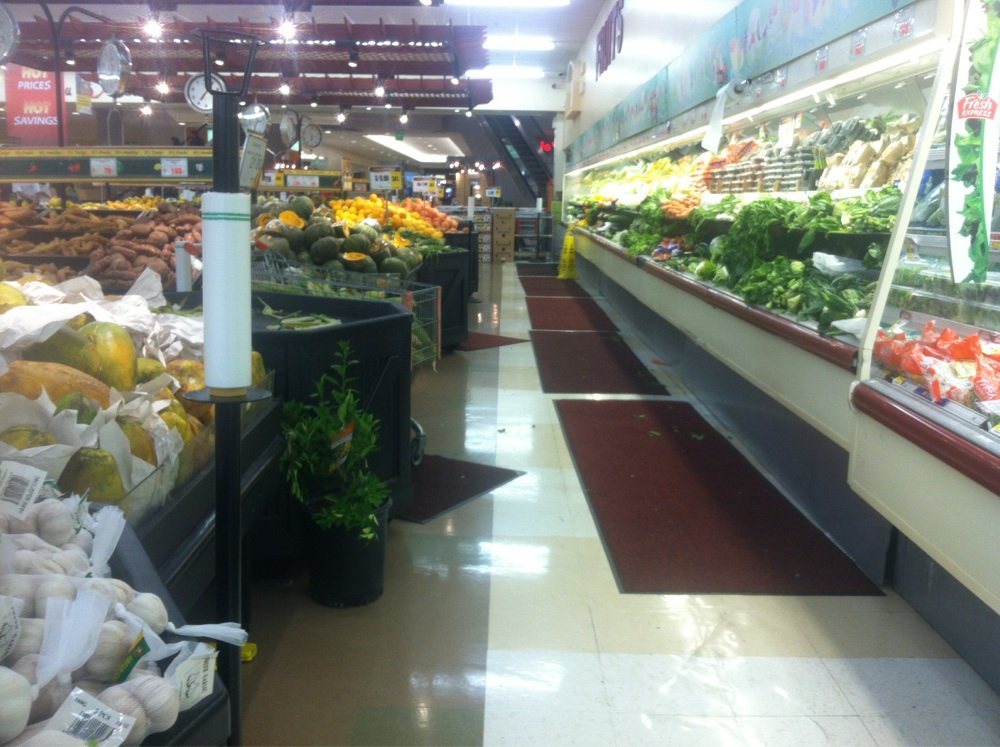
Seafood City is a Filipino market that was founded in 1989 in San Diego. There is quite a lot of seafood and other meat but, considering its name, a lot of produce and other products as well. They also play great music, as I discovered when I Shazamed a song and found out it was “Ligaya” by Eraserheads — knowledge which later allowed me to impress a customer at Arko when the same song came on. Locally there are locations in Carson, Cerritos, Eagle Rock, Gardena, Irvine, North Hills, Panorama City, Pomona, and Rancho Cucamonga. Outside California there are locations in Hawaii, Nevada, and Washington.
SEIWA MARKET (Costa Mesa)

Seiwa Market was founded by Hidejiro Matsu, who after selling his Marukai Market chain to Tokyo-based Don Quijote in 2013, started a new Japanese market in Houston. According to their website, “Seiwa Market offers various Japanese items including fruits, sake, frozen food items, sauces and other imported seasonings and condiments to make a complete meal.” Matsu returned to Southern California when Seiwa opened a market in 2016. There are currently plans to open another in Torrance. The Costa Mesa store is served by OCTA line 43.
SEOUL MARKET (La Cañada Flintridge)

Seoul Market, in La Cañada Flintridge, is a small Korean market, owned by Harold Lee. It’s served by the Glendale Beeline’s 3 and 32 lines.
SHUN FAT SUPERMARKET (El Monte, Garden Grove, Monterey Park, Rowland Heights, San Gabriel, Westminster)

Shun Fat Supermarket (aka Siêu Thị Thuận Phát and 順發超級市場) is a Hoa supermarket chain started by Hieu Tran in 1993. The first location opened in Monterey Park. They’re found mostly in Asian suburbs and interestingly, have in several cases bumped out previous Asian markets. In Westminster, a Shun Fat replaced the original 99 Ranch Market. The individual locations often have distinct alternate names including El Monte Superstore (El Monte), Garden Grove Superstore (Garden Grove), Mar Plaza (Monterey Park), Pacific Square (Rowland Heights), San Gabriel Superstore (San Gabriel), and Westminster Superstore (Westminster). Out of state there are today locations in California, Texas, and Nevada.
SILOM SUPERMARKET (Thai Town)

Silom Supermarket is located in Thailand Plaza, both of which opened for business in 1992. Sharing a roof with Jinda Restaurant, a bookstore, a tailor, and perhaps other businesses. Although not a very large market, it’s the largest Thai Market in Thai Town. It’s served by Metro’s 180/181 line and 217 lines.
SIMPANG (Palms)

Simpang Asia is an Indonesian market and restaurant located in Palms. It carries a selection of Indonesian and Dutch groceries, and also includes a deli/café as well as the highly regarded restaurant. It’s served by LA DOT’s Commuter Express 431 line and the Expo line.
SRI LANKAN DELIGHT (Tarzana)
Sri Lankan Delight is a small Sri Lankan market specializing in Sri Lankan products but also apparently carrying Australian, Canadian, British, Indian, Irish, Japanese, Malaysian, South African, and Thai products. It opened on Ventura Boulevard in Tarzana around 1990. It’s served by Metro’s 15/240 line.
TOKYO CENTRAL (Costa Mesa, Gardena, West Covina)

After Marukai was sold to Tokyo-based Don Quijote, several former Marukai Markets were rebranded Tokyo Central. Currently there’s a Tokyo Central in Costa Mesa and West Covina. There’s a Tokyo Central & Main Pacific Store in Gardena. Tokyo Central & Main Pacific Stores differ in that the reward programs are not available there.
VALLEY SEOUL MARKET (Reseda)
Valley Seoul Market, or Galbi Kim Valley Seoul Market, is a small Korean market, but perhaps the only one in the San Fernando Valley. It’s served by Metro’s 150/240, 169, and Rapid 744 lines as well as LA DOT’s DASH Northridge line.
VALLEY SUPERMARKET (Alhambra)
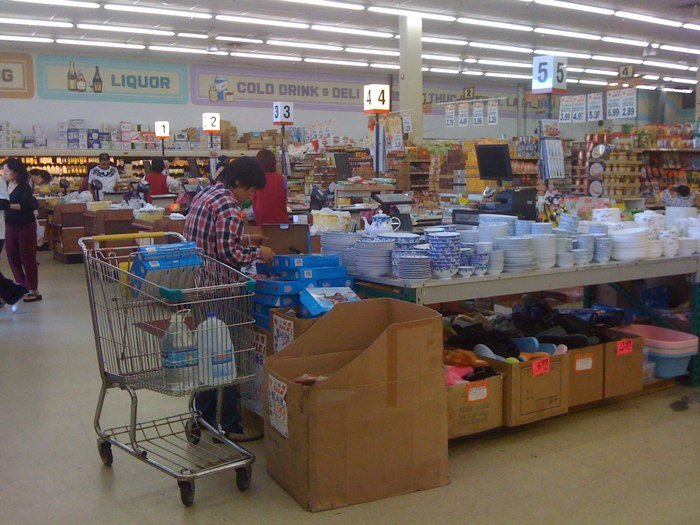
Valley Supermarket (or Quang Hoa Valley Supermarket) is a large-ish market in Alhambra with most signage in Chinese, Vietnamese, and English. It’s the anchor of the Valley Square Shopping Center. The nearest Metro stop is served by the 76 line.
ZION MARKET (Buena Park, Cerritos, Hawaiian Gardens, Irvine, Koreatown)
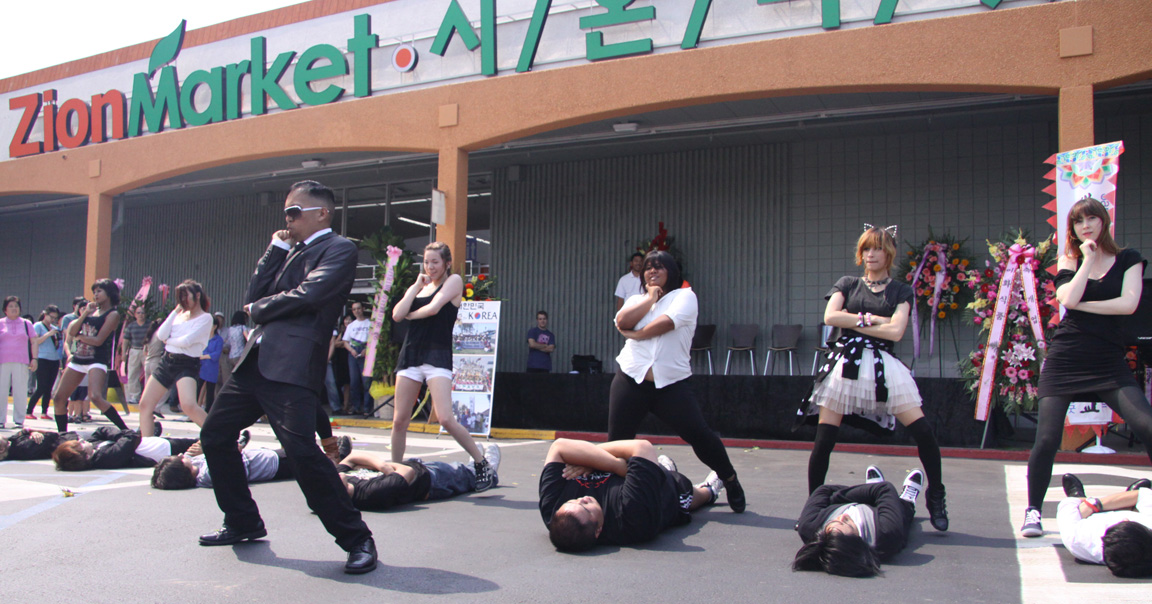
The first Zion Market opened in San Diego in 1979, specializing in Korean and Japanese items. It expanded in size in 1983 and 1984 before relocating to a much larger space, a former Sears, in 2002. In 2006, a second location opened in Hawaiian Gardens. More locations followed, including Irvine (2007), Koreatown (2009), Buena Park (2013), and Cerritos (2013).
Bearing in mind it’s not my intention to list every Asian-owned bakery, convenience store, or gas station food mart, please give me any additions and corrections in the comments.
FURTHER READING
Elson Trinidad‘s “The Asian American Supermarket: More Than Just a Grocery Store“
Clarissa Wei‘s “The ‘Asian Whole Foods’ Is Expanding Across The San Gabriel Valley“
Support Eric Brightwell on Patreon




8 thoughts on “Pan-Asian Metropolis — Los Angeles’s Asian Supermarkets”